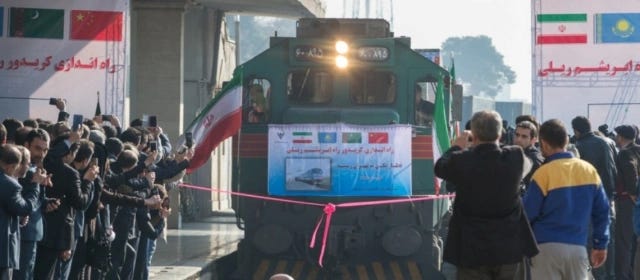Iran-China Rail Cements New Silk Road
Intensified US sanctions on China are poised to accelerate this BRICS trade artery.
On 25 May, the first direct freight train from Xi’an, China, arrived at the Apadana dry port in Eslamshahr, Iran. The train passed through China, Kazakhstan, Uzbekistan, Turkmenistan, Iran, and Turkey in just 15 days, reducing the transit time compared to sea freight by more than half. This development followed a meeting on 12 May between officials from the national railways of the participating countries, who called for the acceleration of the project—likely in anticipation of imminent instability and potential supply chain disruptions. The development accelerates Beijing’s Belt and Road Initiative (BRI) while enhancing Iran’s leverage in negotiations with Washington.
Deepening Ties
The Sino-Iranian relationship has flourished since 1979, evolving alongside the Western sanctions regime imposed on the Islamic Republic. In 2021, the two nations formalised their ties through a 25-year Comprehensive Strategic Partnership (CSP) agreement, a distinction shared in the region only by the United Arab Emirates, Saudi Arabia, and Egypt. China remains Iran’s largest trading partner and the primary importer of its crude oil, accounting for an estimated 90% of Iran’s oil exports. Non-oil trade between the two countries reached $34.1 billion in 2024. Beyond economic and strategic cooperation, China and Iran share deep cultural, historical, and ideological affinities, particularly their shared opposition to Western hegemony, a dynamic less evident in China’s relations with Arab states.
Iran’s strategic geographic position cements its role as a vital hub in the BRI, with further optimisation of this corridor poised to shield the Islamic Republic from escalating economic pressures and the threat of more stringent sanctions. The inaugural freight train from China arrived in Tehran in February 2016, completing a 10,400-km journey from Zhejiang via Kazakhstan and Turkmenistan in 14 days—a landmark achievement in overland transport. Both nations have since committed to expanding the rail network, with China pledging $12 billion towards BRI-related railway projects, including the Qazvin-Rasht-Anzali-Astara line, and Iran allocating $6 billion over six years to bolster its infrastructure. These efforts aim to integrate Iran into the International North-South Transport Corridor (INSTC), a 7,200-km multimodal trade route initiated in 2000 by Russia, Iran, and India to connect South Asia with Europe.
This month’s milestone, which saw the transport of 32 containers of commercial goods on the relaunched Iran-China freight train, underscores the corridor’s potential to reduce Sino-Iranian trade costs, facilitate the transport of Iranian oil, and streamline the delivery of Chinese goods to Europe. The rail link, relaunched in July 2024 at Aprin dry port near Tehran, cuts transit times to approximately two weeks—50% faster than maritime routes—and offers significant cost savings. Amid ongoing nuclear negotiations with the United States, reported in early 2025, this strategic alignment highlights Iran’s ability to forge alternative partnerships. By leveraging its BRICS membership and deepening ties with China and Russia, Iran is strategically positioning itself to press Washington for greater concessions, reinforcing its resilience against Western-imposed constraints.
Partnerships of Steel
The revitalised Iran-China rail corridor represents a critical advancement in the New Silk Road, enhancing trade efficiency and reinforcing Iran’s geostrategic position. Intensified US sanctions on China are poised to accelerate this BRICS trade artery, further deepening Sino-Iranian economic and strategic cooperation. Coupled with the Russo-Iranian Comprehensive Strategic Partnership Agreement, signed earlier this year, this development fortifies the BRICS framework, enhancing its collective resilience against Western economic coercion and cementing Iran’s role as a linchpin in Eurasian connectivity.




